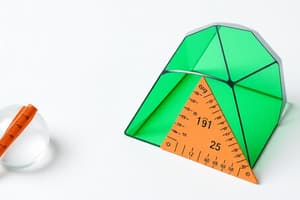Podcast
Questions and Answers
What is the formula for the area of a triangle?
What is the formula for the area of a triangle?
- A = l × w
- A = π × r^2
- A = b × h
- A = (b × h) / 2 (correct)
What is the unit of measurement for the volume of a rectangular prism?
What is the unit of measurement for the volume of a rectangular prism?
- m^2
- cm^2
- m^3
- cm^3 (correct)
What type of angle is greater than 90° but less than 180°?
What type of angle is greater than 90° but less than 180°?
- Acute angle
- Reflex angle
- Right angle
- Obtuse angle (correct)
What is the formula for the volume of a sphere?
What is the formula for the volume of a sphere?
What is the sum of two supplementary angles?
What is the sum of two supplementary angles?
What is the unit of measurement for the area of a circle?
What is the unit of measurement for the area of a circle?
Flashcards are hidden until you start studying
Study Notes
Area Calculation
- Formulas:
- Area of rectangle:
A = l × w(wherelis length andwis width) - Area of triangle:
A = (b × h) / 2(wherebis base andhis height) - Area of circle:
A = π × r^2(whereris radius) - Area of parallelogram:
A = b × h(wherebis base andhis height)
- Area of rectangle:
- Units:
- Square units: cm^2, m^2, km^2, etc.
- Conversion between units: 1 m^2 = 100 cm^2 = 0.0001 km^2
Volume
- Formulas:
- Volume of rectangular prism:
V = l × w × h(wherelis length,wis width, andhis height) - Volume of cylinder:
V = π × r^2 × h(whereris radius andhis height) - Volume of sphere:
V = (4/3) × π × r^3(whereris radius)
- Volume of rectangular prism:
- Units:
- Cubic units: cm^3, m^3, km^3, etc.
- Conversion between units: 1 m^3 = 1000 cm^3 = 0.001 km^3
Angles
- Types of angles:
- Acute angle: Less than 90°
- Right angle: Exactly 90°
- Obtuse angle: Greater than 90° but less than 180°
- Straight angle: Exactly 180°
- Reflex angle: Greater than 180° but less than 360°
- Angle relationships:
- Complementary angles: Sum of two angles is 90°
- Supplementary angles: Sum of two angles is 180°
- Vertical angles: Equal angles formed by two intersecting lines
- Angle measurement:
- Degrees (°)
- Radians (rad)
Area Calculation
- Area of rectangle is calculated by multiplying length and width:
A = l × w - Area of triangle is calculated by multiplying base and height, then dividing by 2:
A = (b × h) / 2 - Area of circle is calculated by multiplying π with the square of the radius:
A = π × r^2 - Area of parallelogram is calculated by multiplying base and height:
A = b × h - Area units include square centimeters (cm^2), square meters (m^2), square kilometers (km^2), and more
- Conversion between units: 1 m^2 = 100 cm^2 = 0.0001 km^2
Volume Calculation
- Volume of rectangular prism is calculated by multiplying length, width, and height:
V = l × w × h - Volume of cylinder is calculated by multiplying π with the square of the radius and the height:
V = π × r^2 × h - Volume of sphere is calculated by multiplying (4/3) with π, then multiplying the result with the cube of the radius:
V = (4/3) × π × r^3 - Volume units include cubic centimeters (cm^3), cubic meters (m^3), cubic kilometers (km^3), and more
- Conversion between units: 1 m^3 = 1000 cm^3 = 0.001 km^3
Angles
- Angles can be classified into five types: acute, right, obtuse, straight, and reflex angles
- Acute angle is less than 90°
- Right angle is exactly 90°
- Obtuse angle is greater than 90° but less than 180°
- Straight angle is exactly 180°
- Reflex angle is greater than 180° but less than 360°
- Complementary angles sum up to 90°
- Supplementary angles sum up to 180°
- Vertical angles are equal angles formed by two intersecting lines
- Angles can be measured in degrees (°) or radians (rad)
Studying That Suits You
Use AI to generate personalized quizzes and flashcards to suit your learning preferences.




